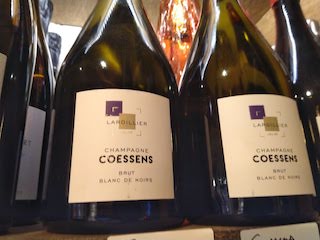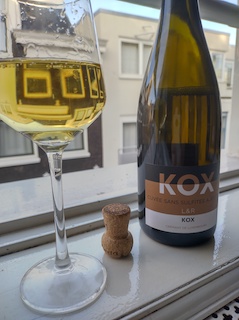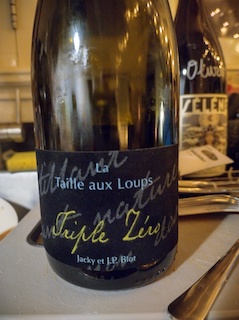Xmas bubbles
With Christmas and new year celebrations, December is the sparkling wine month. Most Champagne, Crément, and other sparkling wines are drunk during the holiday season. Opening a sparkling wine is the sign that the party is about to start, it is a celebration.
But what is sparkling wine, and what are the different families? How to choose some in Amsterdam and how to drink it.
Wine is a regulated product; sparkling wine is not an exception. There is plenty of rules, constraints, and laws that govern the sparkling wine process. To simplify we can rank sparkling wines into 4 categories using the wine elaboration process.
By adding gas to the wine. This method is generally used for low-quality wines. The addition of CO2 can be accomplished in a tank or a bottle. The bubbles are big and don’t stay long. In Europe, it should be written on the bottle.
The second method is more traditional but still contemporary, gasification takes place in a closed tank. The wine is poured into a tank with a fermentation liquor (wine and sugar) and yeasts. After the fermentation, the wine is bottled.
This method is used with most Prosecco, sparkling German wine, or Lambrusco.
The third method is really old, which is why it is called “Ancestrale” (the French word for ancestral, obviously). The fermentation of the wine is stopped generally by using cold. The semi-fermented wine is then bottled without any liquor. Bottles are stored for several months in a temperature-controlled cave where the fermentation continues until all the sugar is consumed by yeasts. The best know example of this method is Blanquette de Limoux, Clairette de Die. This is the way winemakers make PetNat (“Pétillant Naturelle”).
The last method is the most know, it is the traditional method or also called the “Méthode Champenoise”. Here the fermentation is finalized like for any still wine, but during the bottling, a liquor (sugar and yeast) is added (liqueur de tirage). This will initiate a second fermentation that will add the gas. Bottles are stored in a temperature-controlled cave for a few months and up to 5 years. The traditional method is the one used to produce Champagne, but also Crémant and Cava.
In the two last methods, one point is important, the dead yeast stays in the bottle. This is called lees (lies in French). These dead cells will complexify the aromas present in the wine.
Champagne
There are many things to say about Champagne, it could fill an entire book and it can be confusing. So, to be short. The fun fact is, Champagne was originally considered a poor man’s drink, it wasn’t until a monk, Dom Perignon that Champagne become a luxury product. But even then, Champagne was very sweet (more than 60g of sugar per liter). It is only in the middle of the 19th century that gives us the taste of Champagne we know. You have heard that Champagne can only be produced in the Champagne region, it’s not so true, it’s a simplification. There are four main areas where Champagne can be made:
- Vallée de la Marne (From Seine et Marne, Aisne and Marne departements, 3 administratives regions)
- Montagne de Reims, in Marne
- Côte des Blancs and Côte de Sézanne, in Marne
- Côte des Bar in Aube
Each area has its characteristics, tastes, and qualities from the soil and the climate. There are seven grape varieties allowed in Champagne, Chardonnay, Arbane, Petit Meslier, Pinot Blanc, and Pinot Gris for white and Pinot noir and pinot Meunier for Red grapes. But most Champagnes are made from chardonnay, Pinot Noir and Pinot Meunier. You can have Champagnes Blanc de Blanc (White from white), generally 100% Chardonnay, and Blanc de Noir (White from Black), Pinot Meunier, and Pinot Noir. You can also have a Champagne rosé which is a blend of white and red wine, and a Rosé de Saignée with a short maceration of red grapes. Each bottle of Champagne is aged with the lees, for at least 15 months and up to 3 years.
To finish, winemakers can decide to add liquor (sugar and wine) to correct the sugar level of the champagne. This is the mention Brut Nature to Demi-sec (Brut Nature 0 gr, Extra Brut 0-6 gr, Brut 6-12 grr, Extra-Dry 12-17 gr, Dry 17-32 gr, Demi-sec 32-50 gr, Doux +50 gr)
How to choose a Champagne
How to choose a bottle of Champagne, there are several parameters, if you want to have something sweet or not, with white or red grapes, or even a rosé, this is your taste, and nothing tastes like Champagne like another champagne. But there is something to consider when choosing a bottle of Champagne. Is it a Champagne made by a winemaker or by a “Maison de Champagne” who bought grapes across the appellation to create a cuvée? A winegrower’s champagne has an identity, an expression of the “Terroir” and a personality, this can be a new experience in your Champagne Journey.
Is very easy to determine if one Champagne comes from a winegrower or a company buying grapes (“Maison de Champagne”), it is mentioned on the label. On the back label, you should find two letters, RM or NM, and some numbers. These two letters tell you if the wine was made by the winegrower RM – Récoltant Manipulant (harvester and winemaker) or not so you will find, NM – Négociant Manipulant (Trader Manipulating).

My Selection (You can find them in Amsterdam)
Bourgeois Diaz BD’N, From the Marne Valley, 60% Pinot Noir – 40% Pinot Meunier

No dosage, Powerfull and vinous, citrus notes, a unique experience Oyster and this champagne is a must
Olivier Horiot Brut Nature 5 Sens from Côte de Bars
5 grapes, Arbanne, Pinot Meunier, Pinot Noir, Pinot Blanc, Chardonnay. Complex with a sensation of sweetness and tangy freshness Drink with a grilled poultry or foie gras, you can also try canned sardines (special effect)
Where to find it? Vleck wines
Jérôme Coessens Brut Nature, 100% Pinot noir Côte des Bars (Aude)

0 dosage, a beautiful fruit, a smoky touch, and minerality. A perfect expression of Pinot Noir from the Côte des Bars Pair wonderfully with sea urchin
Where to find it? L’atelier du Champagne
Pierre Gimonnet et Fils, Rosé de blancs Chardonnay/Pinot Noir
Just a touch of Pinot Noir to create an unique and very fresh wine with a lemony taste with a finish marked by red fruit. Perfect on a Lobster or grilled seabass. And why not drink a glass on a creamy cheese like a brie.
Where to find it? De Wijnwinkel
Crémant
If you find Champagne too expensive, or not worth the price, or if you did not find the wine you love, there are still some options. Welcome, to the world of Crémant! Crémant wines follow the winemaking process of Champagne with some differences. The aging on lees is 12 months minimum (15 for a Champagne), the pressure in the bottle is about 4 bars (against 5 in Champagne), and Crémant can be made in two Countries, France and Luxembourg, and can be found in 8 french regions.
Crémant de Bordeaux, With around 60% of Sémillon and Sauvignon
Crémant de Limoux, Chenin and Chardonnay, with limited use of Mauzac and Pinot Noir.
Crémant de Die, Clairette, Aligoté and Muscat, very aromatic
Crémant de Savoie, with at least 60% of Jacquère and Altesse, and 40% maximum of Chasselas, Chardonnay, and Gamay.
Crémant du Jura, At least 70 % of chardonnay, pinot noir and trousseau, and savagnin
Crémant de Bourgogne, 20% of the production, two categories of grapes; pinot noir, chardonnay, pinot blanc et pinot gris in majority, then Gamay, Aligoté, and Melon
Crémant d’Alsace, 50% of the French production, varieties Pinot Noir, Blanc and Gris, Auxerrois, Riesling and Chardonnay
Crémant de Loire, 18% of the production, Chenin, Chardonnay, pinot noir, grolleau noir, le grolleau gris and orboi (rarely)
Crémant du Luxembourg many permited grapes Auxerrois, Chardonnay, Pinot and Riesling
My Selection
Domaine KOX, sans sulfite ajouté, Crémant du Luxembourg, Riesling

A rich complexity around a yeasty nose, a real surprise Without any added sulfite Light goat cheese is a must with this wine
Where to find it? Benelux Wine Co
Zulu GUILI GUILI, Crémant du Limoux Chardonnay - Chenin - Mauzac - Maccabeu
one of the most powerful crémant you can have, you complex and fresh with a touch of oxidation. A dorade or fish soup is wonderfull with this wine
Where to find it? Sauvage
Méthode Ancestrale
The last method I wanted to cover is the ancestral method. This is surely the first way people used to create sparkling wines in the past. The process is simple, the wine starts the fermentation like any other still wine, but a one moment, while there is still residual sugar, the fermentation is stopped, and the wine is put in a bottle and begins a new fermentation. This is the privileged method for Clairette de Die, Blanquette de Limoux but also for a lot of natural wine and other PetNat
My Selection
Domaine la taille aux Loups Triple Zero, 100% Chenin, Loire

No sugar, liquor, or sulfite, Golden color, suave, full of ripe flavors, slender and tasty. One of the best Champagne substitutes.
Where to find it? Wijnkoperij Au Paradis
La Salada, Tinc Set, Macabeo, and Xarel-lo, Catalogne

a fruity and dry wine with a lot of fun, perfect for a party with friends Drink it with grilled sausages
Where to find it? De Wijnwinkel